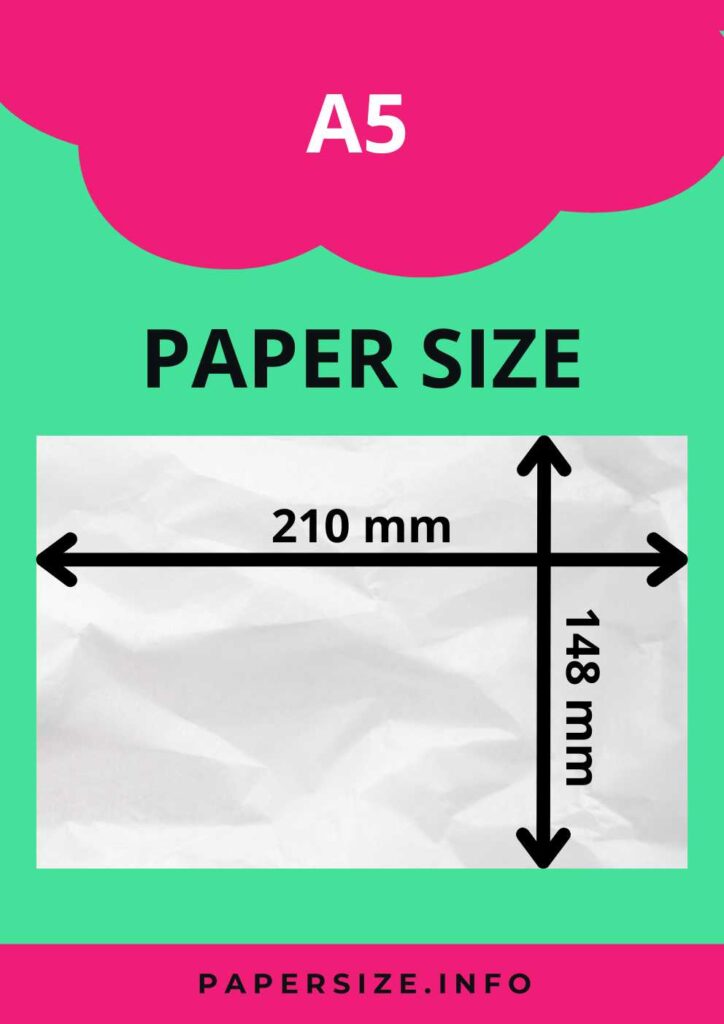A5 Paper Size and Dimensions

A5 paper size, A5 sheet size, A5 paper size in mm, cm, meter, inches and feet. All A5 paper size data in one place.
The A5 paper size is an internationally recognized ISO standard size, predominantly used throughout Europe and the majority of the world, with North America, certain areas of South America, and the Philippines being the primary exceptions. As a component of the A series of paper sizes, A5 is crucial for maintaining consistency in paper sizing globally.
In terms of its relationships within the A series, one sheet of A5 paper is exactly twice the size of an A6 sheet and precisely half the size of an A4 sheet. This standardized ratio ensures that scaling up or down between sizes is seamless and efficient, preserving the content’s aspect ratio and making it easy to adjust documents to various sizes without any layout issues.
A5 Paper Size Dimensions
The A5 size is particularly popular for applications such as small booklets, flyers, journals, and stationary, where a smaller format is preferred for convenience and portability, yet sufficient space is required for clear and legible content.
Here are the precise dimensions of a sheet of A5 paper, provided in various units of measurement:
- A5 paper size in millimeters: 210 mm x 148 mm.
- A5 paper size in centimeters: 21 cm x 14.8 cm.
- A5 paper size in inches: 8 1/4 by 5 7/8 inches.
These dimensions align with the ISO standard, ensuring consistency and compatibility in paper sizes for printing and document creation globally. The A5 size is versatile, commonly used for smaller-scale documents such as notepads, flyers, and brochures, where compactness is appreciated without sacrificing the space needed for adequate information display.
Area of One Sheet of A5 Paper
The A5 paper size, part of the A series, is distinctly designed based on the area of the sheet, with all sizes deriving from the A0 size, which measures 1 square meter. This method of standardization ensures that each step down in size halves the area of the paper, maintaining a consistent and logical reduction across the series.
Area of One Sheet of A5 Paper:
- Square Meters: 0.0313 sq m (exactly 1/32 of a square meter)
- Square Inches: 48.1741 sq in
- Square Feet: 0.3345 sq ft
This area-based approach to sizing in the A series facilitates efficient scaling between sizes for various applications, such as printing and document formatting, while preserving the integrity of content layout and design. The A5 size is particularly favored for items like booklets, brochures, and notepads, where compact dimensions are essential, yet enough space is needed to present information effectively.
A5 Size In Pixels
The conversion of A5 paper size to pixels is an essential consideration for anyone planning to print designs on this size of paper, ensuring that the finished product achieves perfect resolution. However, translating the physical dimensions of A5 paper into pixels depends heavily on the resolution of the printing device or display, measured in dots per inch (DPI).
Understanding DPI and Its Impact:
DPI, or “dots per inch,” indicates how many pixels will be printed or displayed per inch. The typical screen resolution for monitors is between 100 and 120 DPI, despite the common misconception that it is around 72 DPI. For home or office printers, the standard resolution is usually 300 DPI. Professional printing services can vary, offering resolutions from 250 DPI to 600 DPI, and some high-end professional printers may even provide resolutions as high as 1200 DPI.
Pixel Dimensions for A5 Size:
Given these variations in resolution, here are some approximate pixel dimensions for an A5 sheet at different DPI settings:
- 96 DPI: 794 x 559 pixels
- 100 DPI: 827 x 583 pixels
- 120 DPI: 992 x 699 pixels
- 300 DPI: 2480 x 1748 pixels
- 600 DPI: 4961 x 3496 pixels
Importance of Choosing the Right DPI:
It’s crucial to know the specific DPI setting of your printer or display when planning to print a design, as this will ensure that the final output meets your expectations. The right DPI setting is essential for achieving the desired clarity and detail in the printed design. Higher DPI settings result in sharper and more detailed images, but require files with more pixels, which can increase file size and potentially impact printing speeds and costs.
Practical Considerations:
Before starting a design project intended for A5 printing, verify the DPI settings of the printing service or device you plan to use. This preparation allows you to create a design with the optimal number of pixels, ensuring that the dimensions of your digital image precisely match the physical size of the A5 paper. This attention to detail helps prevent issues such as image stretching or pixelation, ensuring high-quality print results.

